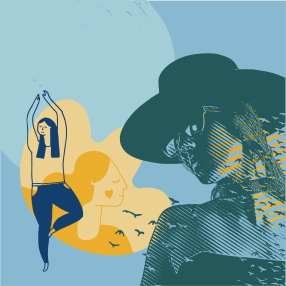It’s likely that you’ve come across images or clips on the internet of massive groups of individuals joyfully tossing vibrant colored powder and paint at each other in celebration of Holi Festival, taking place on March 25th this year.
Do you understand the reason for this annual occurrence of a spectacular rainbow display? And are you aware of the origin of its name?
It is a celebration of the triumph of good over evil.
Holi, celebrated in India and Nepal, is a national holiday that marks the beginning of spring. It is timed to align with the final full moon of the winter season according to the Hindu lunar calendar.
The origins of the religious festival of Holi are based on the story of Holika, which is how the holiday got its name. Holika, who was the sister of the demon king Hiranyakashipu, died in a fire while trying to kill her nephew Prahlad. Prahlad, who was saved by the god Vishnu whom he prayed to, escaped the fire unharmed.
2. It begins with bonfires.
The celebration of Holi in India begins the night before with the traditional lighting of bonfires, known as Holika Dahan. In honor of the fire that killed Holika, people come together to gather around these fires, often adorned with an effigy of Holika. This festival symbolizes the arrival of spring and the warmth it brings, represented by the heat of the flames.
3. The colors represent equal treatment and opportunity.
Holi, also referred to as the ‘festival of colours’, is a celebration of the lively colors of spring. The use of colorful powders and water during this festival not only represent flames, but also hold a significant meaning. It is a tradition for people to cover each other with pigmented ‘abir’ powder and ‘gulal’ paste.
The colors serve as a powerful equalizer, creating a level playing field where everyone is equal (or equally disorganized) regardless of their social class, cultural background, or religious beliefs.
.
Food plays a significant role in the festivities.
Every celebration needs tasty food, and during Holi, the focus is on desserts.
Large quantities of desserts are provided to keep up with the energetic paint throwing. These include Gujiya, which are flaky pastries filled with dried fruit and served with sugar syrup; malpua, which are mini pancakes that are deep-fried; and thandai, a sweet and milky beverage flavored with ingredients such as cardamom, saffron, fennel seeds, and rosewater.
This is a specific energizing beverage.
Bhang is a traditional Indian drink that contains cannabis and is frequently enjoyed during Holi. It is typically mixed with creamy lassi or the previously mentioned thandai.
Although cannabis is considered illegal in India, the law does not explicitly prohibit the consumption of its leaves, which are used to make bhang.
Nepal celebrates Holi with its own unique traditions.
Holi festivities commence in Nepal with the placement of a special bamboo pole, known as a ‘chir’, in the city of Kathmandu. Pieces of fabric are attached to the pole as symbols of good fortune, and it is eventually set ablaze in a bonfire.
In addition to traditional paint and powder, people in Nepal also engage in water balloon fights using ‘lolas.’
The celebration is observed globally.
Although the main festivities occur in India and Nepal, individuals across the globe come together annually to observe the festival, whether for spiritual purposes or simply for enjoyment. This includes locations ranging from Berlin to Barcelona and from Singapore to Suriname (depending on pandemic restrictions).
Unable to paraphrase. Please return all your notifications and comments in English.



